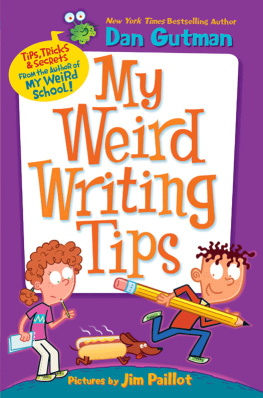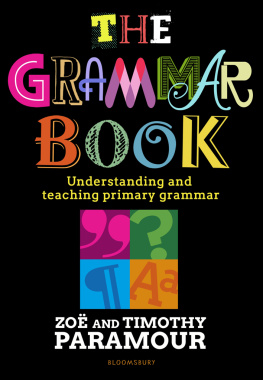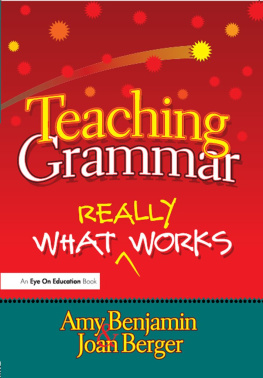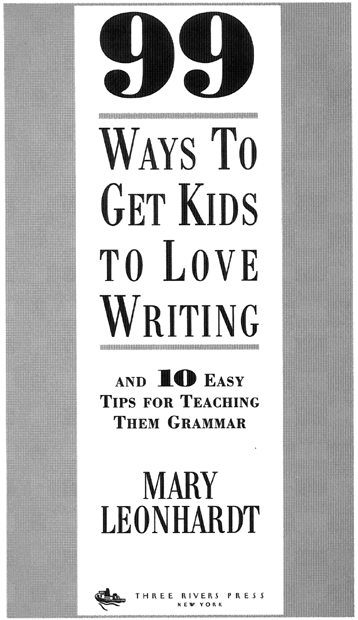C ONTENTS
PART I:
W HY L OVING W RITING I S I MPORTANT
PART II:
99 W AYS TO G ET K IDS TO L OVE W RITING
PART III:
T EN E ASY T IPS FOR T EACHING G RAMMAR
Special Thanks to:
Rich Tombeno, Rachel Ropeik, and Alyssa Galeros for letting me use their writing.
All of my students over the years, who have taught me most of what I know about writing.
My husband, Richard, and my children, Julie, Tim, and Molly, for their love and encouragement.
Introduction
Ive known for years how to turn children into wonderful readers. The trick is to help them, as soon as you can, develop a passion for any kind of reading at all. Ive written extensively about how to do this in my earlier books.
But it took me years to make the writing connection. While I always tried to have my students do some fun, creative writing activities, I mostly went along teaching writing the same old boring way. Write an essay about the imagery in this novel, I might say. Or Heres how to do a character description.
Every so often Id have a few students who wrote simply dazzling character or theme essays, essays that had a richness and personality completely lacking in the work of their classmates. How did they learn to write like that?
Well, they told me. Just as kids who can read and understand difficult, complex literature have a background of reading anything they can get their hands on, the best writers have a background of doing plenty of writing just for the fun of it. They wrote songs and poetry. They left a trail of locked diaries scattered throughout their childhood. They entertained themselves in boring history classes by writing stories in their history notebooks. One girl told me she wrote her best poetry during physics lectures. They wrote anywhere and everywhere, and by the time they were writing in my English classroom, they were light-years ahead of their classmates.
What follows in this book is much of what they told me about how they developed their love of writing. Based on the new realizations that Ive come to, I teach writing completely differently now. Along with the traditional forms (literary essays, research papers, etc.), my students do a great deal of independent, creative writingand I am getting, by far, the best writing Ive ever seen in twenty-eight years of teaching English.
Once kids fall in love with writing, their writing just takes off. Its really worth it, as a parent, to spend a bit of time understanding how to make this happen. So read on! And Id love to hear comments or suggestions. You can write to me c/o Crown Publishing, 201 E. 50th Street, New York, NY 10022, or E-mail me at .
PART I:
WHY LOVING WRITING
IS IMPORTANT
A passion for an activity is the pre-requisite for success in any field. Writing is no different.
We have a cultural belief, probably inherited from our Puritan ancestors, that learning should be rigorous and a bit unpleasant. To see rows of children glumly attempting to write tightly structured analytical essayswhile dreaming of being out on a baseball fieldgives us that wonderful, satisfied, sanctimonious, adult feeling that were training our children well.
But were not Just as a baseball team composed of players who hate and dread the game has little chance of winning, children who hate and dread writing have little chance of writing well.
Only children who love writing write with the frequency and care necessary for them to become excellent writers.
The average junior-high or high-school English teacher has a hundred and fifty students, and forty-five minutes of preparation time a day. The average elementary-school teacher has twenty-five children, and little, if any, preparation time every dayand shes teaching six or seven completely different subjects.
This means that most students are asked to do very little writing in school. It takes at least ten or fifteen minutes to respond thoughtfully to a piece of writing, and few teachers have that kind of time. A weeks writing for one hundred and fifty students would take a teacher about thirty hours of grading time.
The result is that only students who have an independent writing life outside of school learn to write really wellbecause they are the only students who really get any practice.
What if we tried to develop outstanding tennis players by having them on the court only an hour or two once every three or four weeks? Thats a joke, right? Yet thats what happens in schools with writing.
Only students who love writing, and write extensively on their own, develop their own voice and personal style.
We are inundated with dreary, voiceless, muddy prose today. Open any textbook. Read most business writing. Read education writing. Writers who are really readable are those who write with some personalitywith a little humor, or some embedded imagery, or an authoritative, distinctive tone. Writers who only do academic or business writing have an extraordinarily hard time developing a distinctive style.
I once asked my daughter, a college soccer coach who has done extensive recruiting for a number of Division I universities, what a top player looks like. Theyre called personality prayers, Julie told me. When they get on a field they make things happen.
Really top writers are personality writers, and by doing only school writing, its almost impossible to acquire that sense of language, that fresh outlook and individual voice, that characterizes their work.
Only kids with an independent writing life learn how to write with a sharp, clear focus.
Since most testing is objective, students dont learn how to compose or focus their thoughts themselves, an essential requirement for the workplace. After all, when you walk into your bosss office with a proposal for a new program, he doesnt say, Okay, is your program (A) risky but perhaps have the potential to increase profits? (B) safe but in need of a large capital investment? or (C) somewhat safe, if sales Well, you get the idea. The boss will say, Tell me about the program. Why should we use it? Children who have spent thousands of hours focusing their ideas in various pieces of writing are going to be much better prepared, as adults, to present their ideas with clarity and force.
I also think there is a cautious, dreary element to much academic writing, perhaps because it is written to impress a teacher, or an editor of an arcane academic journal. Vivid, readable, tightly focused pieces of writing are not thick on the academic ground.
Children need to write (and read) frequently, and freely, in order to become adept at using complex, grammatically correct sentence structure.
Try this: Find a three-year-old and ask her to repeat this sentence word for word: If I were rich, I would buy you the sun and the moon. I can almost guarantee that shell say something like Im rich, and Ill buy you the sun and the moon. This is because she has not yet started using the subjunctive mood in her own speech, so she cant even repeat it.
Likewise, children wont start using gerund phrases and embedded adjective clauses in their sentences just because a teacher has shown them in class what they are. Its only when theyve seen many of them in their reading, and done a good deal of writing, that they start creeping in, and Jane lives behind me and is the best pitcher on our softball team and likes Popsicles, too becomes Jane, my Popsicle-loving friend who lives behind me, is the best pitcher on our softball team.














